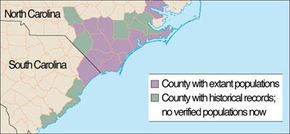Flytrap Background
Although the Venus Flytrap has captivated people across the world, the plants actually grow in an incrediblysmall geographic area. In the wild, they are found in a 700-mile region along the coast of North and South Carolina. Within this area, the plants are further limited to living in humid, wet and sunnybogsand wetland areas. Because Venus Flytraps are so scarce, some early botanists doubted their existence, despite all the stories spread about a flesh-eating plant.
The Name Game
So, how did the plant end up with the intriguing name of Venus Flytrap? It's not too hard to imagine how 'Flytrap' might relate to its insect-catching abilities, but 'Venus' is less clear-cut. According to theInternational Carnivorous Plant Society, the origin of the name is quite lurid. The Venus Flytrap was first studied in the 17th and 18th centuries, when societal mores were a bit more puritanical than they are today, and were somewhat obsessed by human urges and sins. Women in particular were often portrayed as temptresses, greedy for power. The botanists of this time apparently found a parallel between the trap of the plant -- capturing and digesting insects -- and certain aspects of female anatomy and behavior. Thus, the story goes that they named the plant after Venus, the pagan goddess of love and money.
Advertisement



